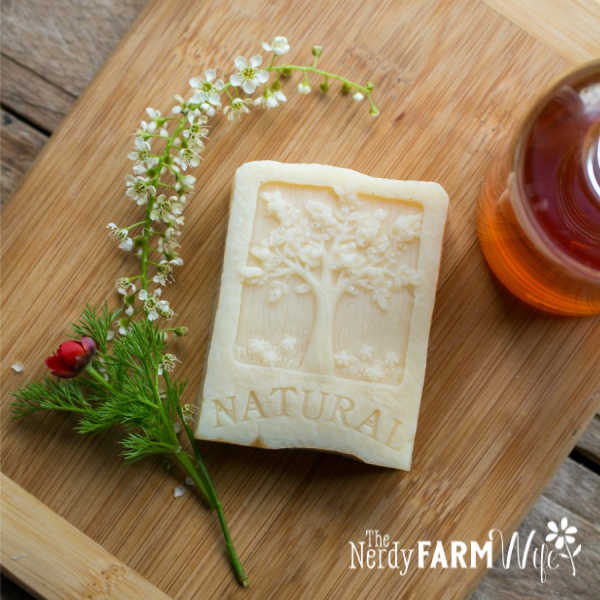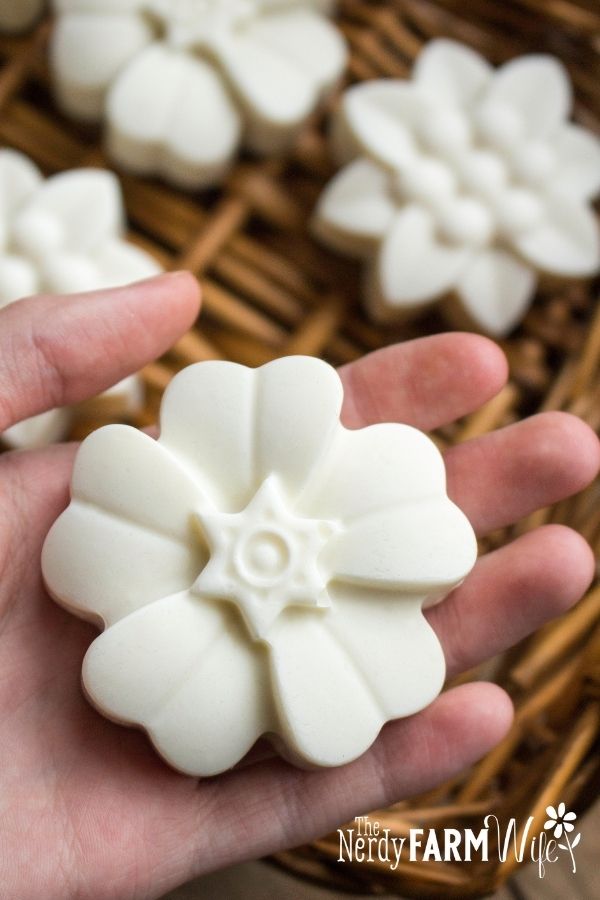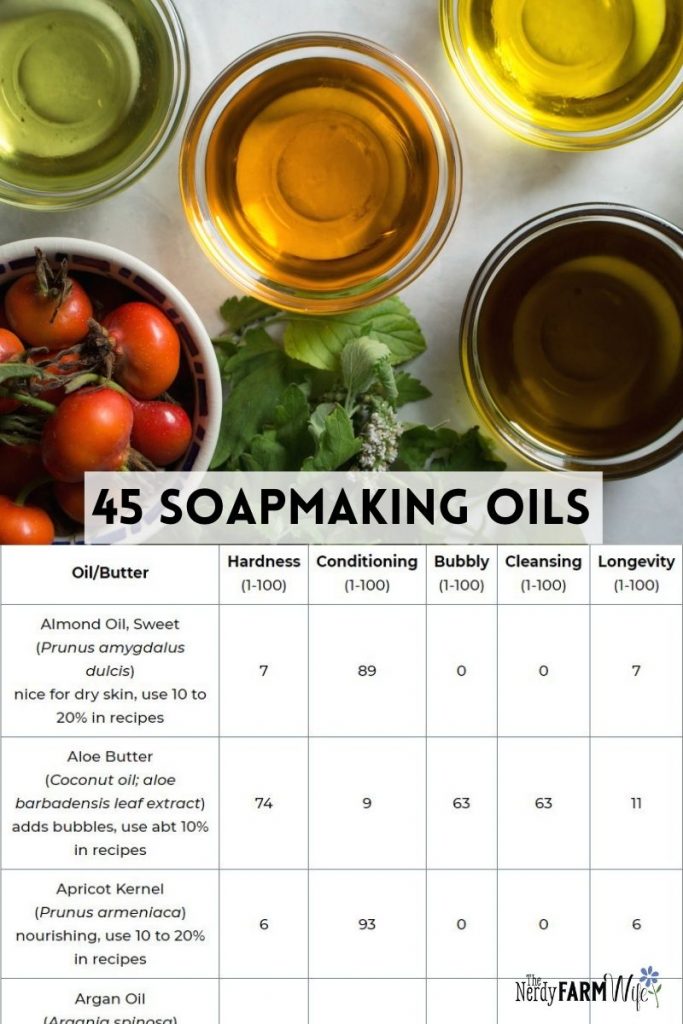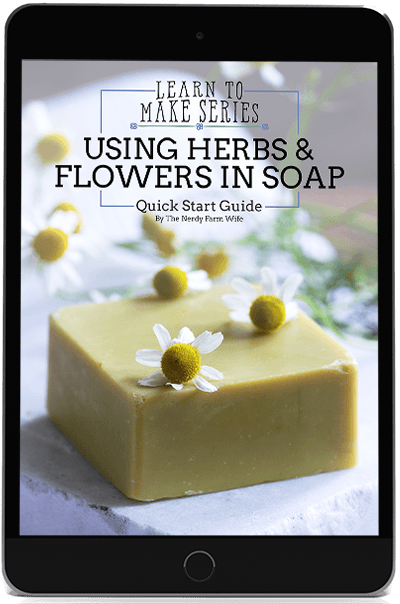Soapmaking Oils Properties and Chart
This helpful reference chart covers 45 soapmaking oils and their characteristics, including hardness, conditioning, bubbly, cleansing, and longevity properties.
It will be helpful to use as a guide when you want to swap out oils in a natural soap recipe!
Before we get into the chart, let’s cover what each column means, as it relates to soapmaking.
I want to stress though that numbers aren’t everything! I often see newer soapmakers get hung up on making their recipe fit neatly into recommended numbers, at the expense of the creative process and sometimes miss out on making some really great recipe ideas!
Just use these numbers loosely as informational aids, since soap calculators don’t take into account things such as sodium lactate or salt for hardening, aloe or honey or milk for extra lather or creaminess, the amount of your recipe’s superfat, extended cure times, discounted water amount, our unique personal preferences that we look for in a soap, and more.

Property Definitions
In the Oil/Butter column, I have the oil’s name, Latin name or INCI (name that it’s internationally known as), a brief line on how it is in soap, and suggested usage rates. (They are suggestions only, based on my personal experiences and preferences – feel free to experiment outside of those numbers!)
Hardness indicates how well the oil adds to the overall hardness of the soap. A higher number makes for a harder soap. As mentioned above, the numbers don’t tell the whole story here though. Olive oil has a low hardness number of 17, but after an extended cure time, can become a really nice hard soap.
Conditioning is how nice and soothing the oil feels on your skin when made into soap. Oils with a low conditioning number, such as coconut oil or babassu oil, can make your skin feel more tight or dry if used in excess, and/or with a too-low superfat. Oils with a high conditioning number feel nice on your skin, but note that too much total conditioning may come at the price of lower lather and soft soap.
Bubbly is pretty self-explanatory. A higher number means that the oil helps produce or support lots of bubbles when used in soap. A low number or zero, means it doesn’t really contribute to overall lather, but that doesn’t mean your soap will have zero lather. A soap that’s not bubbly can still clean your skin.
Cleansing is based on how well the oil-turned-into-soap will dissolve in hard or salt water, but it also indicates its effectiveness at stripping moisture and oil from your skin. A high cleansing number (such as coconut oil) might feel very harsh on many skin types, unless balanced with a higher superfat and/or other conditioning ingredients. If an oil has a low or zero cleansing number, that doesn’t mean it won’t clean your skin. It means that it’s not as likely to strip your skin or leave it feeling tight and dry after use.
Longevity indicates a rough idea of how long the soap will last when used. A higher number is longer lasting, but a trade-off is that if a soap’s overall longevity number is too-high, it may affect lather/bubbles. If you want your soaps to last longer, look for oils with a higher longevity number.

How to Use the Oils Properties Chart
Print the chart out (look for the green print friendly button at the bottom of this article, and select which parts you want to print) and use it to help you figure out oil substitutions or recipe tweaks, or as a reference when creating your own recipe.
For example, if you make a soap and find it’s not bubbly enough, try checking through the list and finding oils that have a higher bubbly number, then experiment with higher rates of those in your recipe.
Related: My article, How to Make Test Batches of Soap, might help you plan out mini test batches while you dial a recipe in, and my digital Soapmaking Journal is a great way to record all of your soapy experiments!
If you don’t see a favorite oil listed here, no worries! I only picked out the oils I had the most personal experience with using in soap, but you can head over to the Soapee Lye Calculator, click on the desired oil name in box 6, and you’ll see its properties listed to the right of that box.
Reference Chart of Soapmaking Oils & Their Properties
Characteristics & suggested usage rates are sourced from my personal experience and notes, while the property numbers are sourced from Soapee Lye Calculator.
| Oil/Butter | Hardness (1-100) | Conditioning (1-100) | Bubbly (1-100) | Cleansing (1-100) | Longevity (1-100) |
| Almond Oil, Sweet (Prunus amygdalus dulcis) nice for dry skin, use 10 to 20% in recipes | 7 | 89 | 0 | 0 | 7 |
| Aloe Butter (Coconut oil; aloe barbadensis leaf extract) adds bubbles, use abt 10% in recipes | 74 | 9 | 63 | 63 | 11 |
| Apricot Kernel (Prunus armeniaca) nourishing, use 10 to 20% in recipes | 6 | 93 | 0 | 0 | 6 |
| Argan Oil (Argania spinosa) adds luxurious quality to body & shampoo bars, use 5 to 10% | 15 | 81 | 1 | 1 | 14 |
| Avocado Butter (Hydrogenated avocado oil) lovely moisturizing feel, use 10 to 20% | 31 | 61 | 0 | 0 | 31 |
| Avocado Oil (Persea gratissima) moisturizing, nice for dry skin or eczema, use 10 to 20% | 22 | 70 | 0 | 0 | 22 |
| Babassu Oil (Orbignya oleifera) bubbly, good sub for coconut oil, higher amounts may feel drying, use 10 to 25% | 85 | 10 | 70 | 70 | 15 |
| Oil/Butter | Hardness | Conditioning | Bubbly | Cleansing | Longevity |
| Camelina Seed (Camelina sativa seed) nourishing, moisturizing, use 5 to 10% | 8 | 88 | 0 | 0 | 8 |
| Camellia Seed (Camellia oleifera seed) gentle for aged or sensitive skin, use 5 to 10% | 11 | 85 | 0 | 0 | 11 |
| Canola Oil (Canola oil) affordable sub for olive oil, use up to 25% | 6 | 91 | 0 | 0 | 6 |
| Castor Oil (Ricinus communis) supports lather, use 3 to 7% in soap; up to 12 to 15% in shampoo bars | 0 | 98 | 90 | 0 | 0 |
| Cocoa Butter (Theobroma cacao) adds hardness, creamy lather; use 5 to 20% | 61 | 38 | 0 | 0 | 61 |
| Coconut Oil (76°) (Cocos nucifera) solid below 76 degrees F, melts to liquid at hotter temps, adds bubbles, very cleansing; use 10 to 30% (increase superfat with higher amount) | 79 | 10 | 67 | 67 | 12 |
| Coconut Oil, fractionated (Cocos nucifera) liquid even at cold temperatures, can feel harsh & drying, not usually recommended for soap, or use a small percentage, abt 3% | 100 | 0 | 100 | 100 | 0 |
| Cupuacu Butter (Theobroma grandiflorum seed butter) adds some hardness and nice feel, similar to shea and mango; use 5 to 20% | 43 | 44 | 0 | 0 | 43 |
| Oil/Butter | Hardness | Conditioning | Bubbly | Cleansing | Longevity |
| Grapeseed Oil (Vitis vinifera seed oil) conditioning, but may have shorter shelf life; use 5 to 10% | 12 | 88 | 0 | 0 | 12 |
| Hazelnut Oil (Corylus avellana seed oil) feels nice on skin, may have shorter shelf life in soap, use 5 to 10% | 8 | 85 | 0 | 0 | 8 |
| Hemp Oil (Cannabis sativa seed oil) may help dry or problem skin types, dark green unrefined lightly tints soap, use 5 to 15% | 8 | 90 | 0 | 0 | 8 |
| Jojoba Oil (Simmondsia chinensis) excellent for shampoo & facial bars, may extend shelf life, use 5 to 10% | 0 | 12 | 0 | 0 | 0 |
| Kokum Butter (Garcinia indica) similar to cocoa butter, hardens soap, use 5 to 20% | 60 | 37 | 0 | 0 | 60 |
| Kukui Nut Oil (Aleurites moluccanus) nourishing lovely feel, use 5 to 10% | 8 | 91 | 0 | 0 | 8 |
| Lard (Pig Tallow) makes a hard soap with low lather, use to replace palm oil, use 5 to 35%, or more | 42 | 52 | 1 | 1 | 41 |
| Laurel Fruit Oil (Lauris nobilis fruit oil) used in Aleppo-style soap, adds some color, scent & lather, lovely for skin, use 20 to 30% with the balance of the recipe as olive oil | 42 | 58 | 26 | 26 | 16 |
| Oil/Butter | Hardness | Conditioning | Bubbly | Cleansing | Longevity |
| Mango Butter (Mangifera indica) adds some hardness, nourishing feel, use 5 to 20% | 49 | 48 | 0 | 0 | 49 |
| Meadowfoam Oil (Limnanthes alba) conditioning, may extend shelf life of soap, use around 10% | 0 | 95 | 0 | 0 | 0 |
| Murumuru Butter (Astrocaryum murumuru) good sub for coconut oil, use 5 to 20% | 82 | 18 | 73 | 73 | 9 |
| Neem Seed Oil (Melia azadirachta) used for troublesome skin or flea/insect repellant, strong smell, not for pregnancy, use 5 to 7% | 39 | 58 | 2 | 2 | 37 |
| Olive Oil (Olea europaea) starts out soft, but hardens with a long cure, low lather, use from 5 to 100% | 17 | 82 | 0 | 0 | 17 |
| Palm Kernel Oil (Elaeis guineensis) similar to coconut oil, hardens, adds bubbles, can feel drying if too high, use 5 to 20% | 75 | 18 | 65 | 65 | 10 |
| Palm (Fruit) Oil (Elaeis guineensis) hardens soap, long lasting, can be replaced with tallow or lard, or a mix of butters, use up to 35% | 50 | 49 | 1 | 1 | 49 |
| Oil/Butter | Hardness | Conditioning | Bubbly | Cleansing | Longevity |
| Peach Kernel (Prunus persica) nourishing for sensitive or dry skin, use 5 to 10% | 8 | 91 | 0 | 0 | 8 |
| Pumpkin Seed (Cucurbita pepo) rich in essential fatty acids, use 5 to 15% | 19 | 83 | 0 | 0 | 19 |
| Rice Bran (Oryza sativa) great sub for all or part of the olive oil in a recipe, try around 15 to 25% in a recipe | 26 | 74 | 1 | 1 | 25 |
| Rosehip (Rosa rubiginosa) luxury oil for mature or sensitive skin, use 5 to 10% | 6 | 89 | 0 | 0 | 6 |
| Safflower, high oleic (Carthamus tinctorius) makes a nice sub for part or all of the olive oil in a recipe, use 5 to 20% | 7 | 92 | 0 | 0 | 7 |
| Sesame Oil (Sesamum indicum) may have a slightly shorter shelf life in soap, use the light kind – not the toasted strongly scented kind, use 5 to 10% | 15 | 83 | 0 | 0 | 15 |
| Shea Butter (Butyrospermum parkii or Vitellaria paradoxa) nourishing, slightly hardens soap, use 5 to 20% | 45 | 54 | 0 | 0 | 45 |
| Oil/Butter | Hardness | Conditioning | Bubbly | Cleansing | Longevity |
| Soy Wax (Hydrogenated Soybean Oil) used to add hardness to soap, try around 2 to 3% for cold process soap, can use higher amounts in hot process and shave soap | 98 | 0 | 0 | 0 | 98 |
| Stearic Acid used to add hardness to soap, try around 2 to 3% for cold process, higher amounts in shave soap and hot process | 99 | 0 | 0 | 0 | 99 |
| Sunflower, high oleic (Helianthus annuus) low silky lather, nice for dry or sensitive skin, use 10 to 20% | 7 | 88 | 0 | 0 | 7 |
| Tallow (Beef) adds hardness, use to replace palm oil, use 5 to 35% in recipes | 58 | 40 | 8 | 8 | 50 |
| Tamanu Oil (Calophyllum inophyllum) excellent for various skin conditions, use around 5% | 25 | 73 | 0 | 0 | 25 |
| Tucuma Butter (Astrocaryum tucuma) adds hardness and bubbles, use 5 to 15% | 77 | 13 | 71 | 71 | 6 |
| Ucuuba Butter (Virola Surinamensis) hardens soap, try 3 to 5% in recipes | 100 | 0 | 92 | 92 | 8 |
| Wheat Germ Oil (Triticum vulgare) nourishes dry, mature, or damaged skin, use around 5% | 19 | 75 | 0 | 0 | 19 |





Thank you for this article…all the best!
Hi Sharon, I’m so glad you found the article helpful! ❤
This is a very very useful chart for me.
I love it that I can see oils and their properties at once.
I think it helps reduce the time to think about what oil to choose when making my own soap.
Thank you for your nice chart!!!
Hi Jun! I’m so happy to hear the chart is useful for you! ?
This is real good thank you so much for simplifying work in the soap making world.
Hi Denis, I’m glad you found the information on soapmaking oils helpful! :)
Question why is it my soaps aren’t as white in appearance? I’m assuming it’s the olive oil giving the green tint? Any way I can change that? Love all the articles!!!! Love the books too!!!
Hi Amy! So glad to hear you enjoy the articles & books! :)
Yes, extra virgin olive oil can slightly affect the tint.
Some tips for whiter soap:
– use the lightest clearest oils you can find
– increasing the coconut oil amount can help whiten soap (but it can make soap more drying, so needs to be balanced with a higher superfat)
– you can try whitening your soap with zinc oxide (or titanium dioxide if not trying for all-natural soap), or white kaolin clay (make sure it’s a very white clay and mix it into the hot lye solution)
– check the essential oils that you’re using – some like citrus and patchouli can tint soap yellow or tan
– check for ingredients with natural sugars – honey, milk, herbal teas can all darken soap
– keep temperatures low, avoid gel phase
Jan, I love this oil chart. I have a question though, I have your Melt & Pour Soap book and I am making the Rose Facial Soap. I do not have sunflower oil, mentions I can use my favorite oil. Can you tell me what oils you do and do not recommend I add to melt and pour? Any not recommended for the face? Too harsh, etc.? Thanks a bunch! Love your book, and your site.
Hi Carol! I’m so glad you like the chart!
I can’t think of any I wouldn’t add to melt and pour soap – except maybe too much sea buckthorn oil, since it can stain your skin at higher amounts.
I’d also save any super expensive oils for leave-on products like salves or lotions, since soap only stays on your skin a short time then washes right away.
Some oils that are great for your face and would work well in melt and pour include:
jojoba, argan, grapeseed, rosehip, apricot kernel oil, sweet almond oil, rice bran oil
If you don’t have any of those, let me know what you have on hand & I’m sure we can find one you can use! :)
Very useful article….thanks for it!!
Hi Meenakshi, I’m glad you found the information on soapmaking oils helpful! ?
Good day every one. Can you please help me. I made soap Noodles from palm, coconut castor oil and lorice acid.
After a day it became very crispy can you please let me know how to become like Noodles because when ever I wanted to make soap from it. There was no shining and had cracks. Thanks friend
Hi Hamidi! I’m so sorry to hear that your project didn’t turn out like you planned.
I’m not familiar with making soap noodles as you describe, so if you share your recipe and some details about how they’re used, that would help us know if we have some troubleshooting ideas. :)